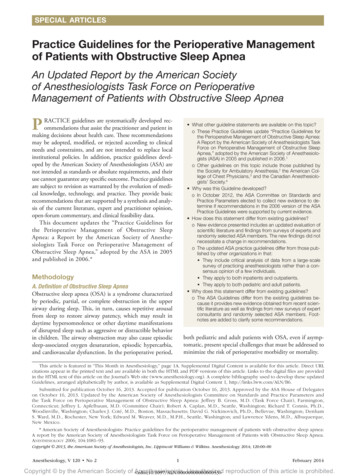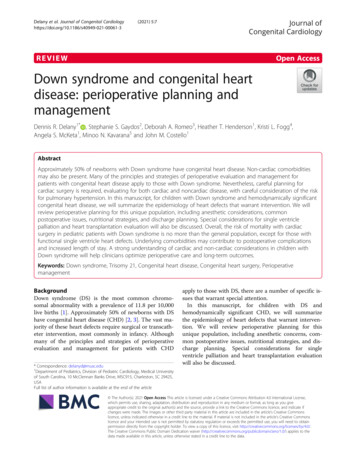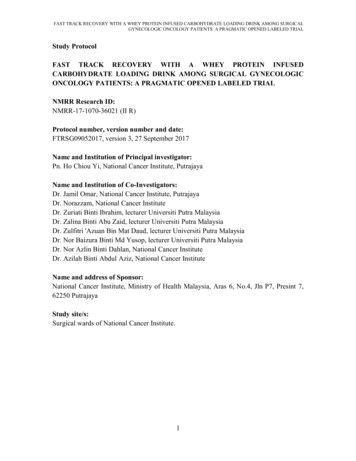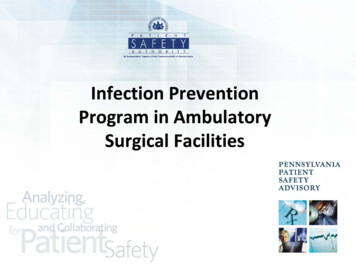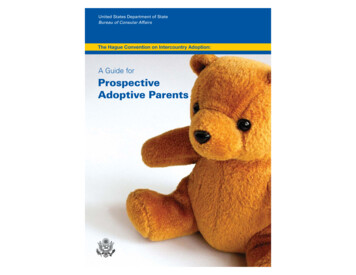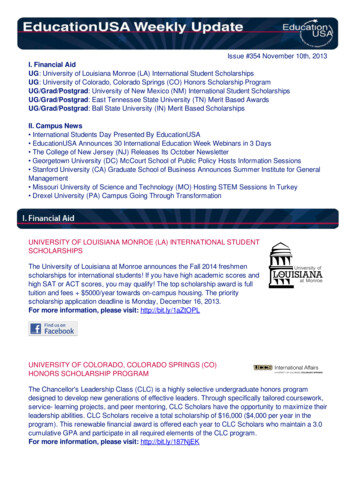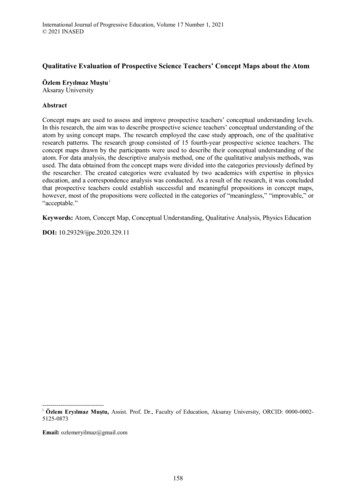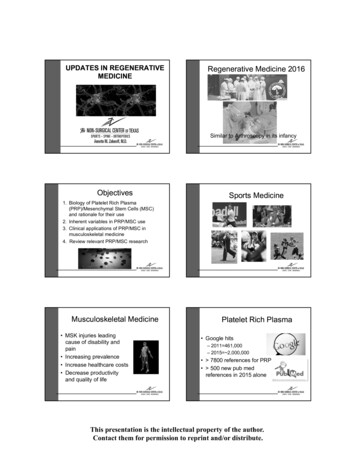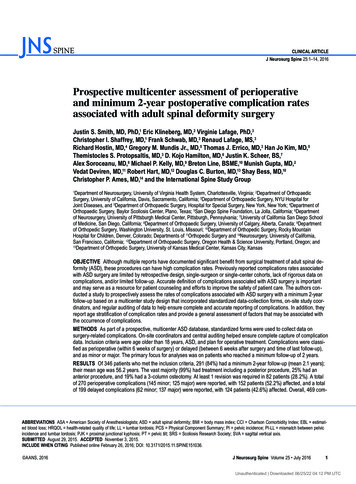
Transcription
clinical articleJ Neurosurg Spine 25:1–14, 2016Prospective multicenter assessment of perioperativeand minimum 2-year postoperative complication ratesassociated with adult spinal deformity surgeryJustin S. Smith, MD, PhD,1 Eric Klineberg, MD,2 Virginie Lafage, PhD,3Christopher I. Shaffrey, MD,1 Frank Schwab, MD,3 Renaud Lafage, MS,3Richard Hostin, MD,4 Gregory M. Mundis Jr., MD,5 Thomas J. Errico, MD,3 Han Jo Kim, MD,5Themistocles S. Protopsaltis, MD,3 D. Kojo Hamilton, MD,6 Justin K. Scheer, BS,7Alex Soroceanu, MD,8 Michael P. Kelly, MD,9 Breton Line, BSME,10 Munish Gupta, MD,2Vedat Deviren, MD,11 Robert Hart, MD,12 Douglas C. Burton, MD,13 Shay Bess, MD,10Christopher P. Ames, MD,14 and the International Spine Study GroupDepartment of Neurosurgery, University of Virginia Health System, Charlottesville, Virginia; 2Department of OrthopaedicSurgery, University of California, Davis, Sacramento, California; 3Department of Orthopaedic Surgery, NYU Hospital forJoint Diseases, and 5Department of Orthopaedic Surgery, Hospital for Special Surgery, New York, New York; 4Department ofOrthopaedic Surgery, Baylor Scoliosis Center, Plano, Texas; 5San Diego Spine Foundation, La Jolla, California; 6Departmentof Neurosurgery, University of Pittsburgh Medical Center, Pittsburgh, Pennsylvania; 7University of California San Diego Schoolof Medicine, San Diego, California; 8Department of Orthopaedic Surgery, University of Calgary, Alberta, Canada; 9Departmentof Orthopedic Surgery, Washington University, St. Louis, Missouri; 10Department of Orthopedic Surgery, Rocky MountainHospital for Children, Denver, Colorado; Departments of 11Orthopedic Surgery and 14Neurosurgery, University of California,San Francisco, California; 12Department of Orthopaedic Surgery, Oregon Health & Science University, Portland, Oregon; and13Department of Orthopedic Surgery, University of Kansas Medical Center, Kansas City, Kansas1Objective Although multiple reports have documented significant benefit from surgical treatment of adult spinal deformity (ASD), these procedures can have high complication rates. Previously reported complications rates associatedwith ASD surgery are limited by retrospective design, single-surgeon or single-center cohorts, lack of rigorous data oncomplications, and/or limited follow-up. Accurate definition of complications associated with ASD surgery is importantand may serve as a resource for patient counseling and efforts to improve the safety of patient care. The authors conducted a study to prospectively assess the rates of complications associated with ASD surgery with a minimum 2-yearfollow-up based on a multicenter study design that incorporated standardized data-collection forms, on-site study coordinators, and regular auditing of data to help ensure complete and accurate reporting of complications. In addition, theyreport age stratification of complication rates and provide a general assessment of factors that may be associated withthe occurrence of complications.Methods As part of a prospective, multicenter ASD database, standardized forms were used to collect data onsurgery-related complications. On-site coordinators and central auditing helped ensure complete capture of complicationdata. Inclusion criteria were age older than 18 years, ASD, and plan for operative treatment. Complications were classified as perioperative (within 6 weeks of surgery) or delayed (between 6 weeks after surgery and time of last follow-up),and as minor or major. The primary focus for analyses was on patients who reached a minimum follow-up of 2 years.Results Of 346 patients who met the inclusion criteria, 291 (84%) had a minimum 2-year follow-up (mean 2.1 years);their mean age was 56.2 years. The vast majority (99%) had treatment including a posterior procedure, 25% had ananterior procedure, and 19% had a 3-column osteotomy. At least 1 revision was required in 82 patients (28.2%). A totalof 270 perioperative complications (145 minor; 125 major) were reported, with 152 patients (52.2%) affected, and a totalof 199 delayed complications (62 minor; 137 major) were reported, with 124 patients (42.6%) affected. Overall, 469 com-Abbreviations ASA American Society of Anesthesiologists; ASD adult spinal deformity; BMI body mass index; CCI Charlson Comorbidity Index; EBL estimated blood loss; HRQOL health-related quality of life; LL lumbar lordosis; PCS Physical Component Summary; PI pelvic incidence; PI-LL mismatch between pelvicincidence and lumbar lordosis; PJK proximal junctional kyphosis; PT pelvic tilt; SRS Scoliosis Research Society; SVA sagittal vertical axis.submitted August 29, 2015. accepted November 3, 2015.include when citing Published online February 26, 2016; DOI: 10.3171/2015.11.SPINE151036. AANS, 2016J Neurosurg Spine Volume 25 July 20161Unauthenticated Downloaded 06/25/22 04:12 PM UTC
J. S. Smith et al.plications (207 minor; 262 major) were documented, with 203 patients (69.8%) affected. The most common complicationcategories included implant related, radiographic, neurological, operative, cardiopulmonary, and infection. Higher complication rates were associated with older age (p 0.009), greater body mass index (p 0.031), increased comorbidities (p 0.007), previous spine fusion (p 0.029), and 3-column osteotomies (p 0.036). Cases in which 2-year follow-up wasnot achieved included 2 perioperative mortalities (pulmonary embolus and inferior vena cava injury).Conclusions This study provides an assessment of complications associated with ASD surgery based on a prospective, multicenter design and with a minimum 2-year follow-up. Although the overall complication rates were high, ininterpreting these findings, it is important to recognize that not all complications are equally impactful. This study represents one of the most complete and detailed reports of perioperative and delayed complications associated with ASDsurgery to date. These findings may prove useful for treatment planning, patient counseling, benchmarking of complication rates, and efforts to improve the safety and cost-effectiveness of patient NE151036Key Words adult spinal deformity; complications; prospective; scoliosis; surgeryIt is well recognized that many developed countries,including the United States, are experiencing an unprecedented demographic shift toward an older population. As the ranks of the elderly grow, it will be increasingly important to appreciate and address their health careneeds. Although the prevalence of adult spinal deformity(ASD) has been estimated to range from 2% to 32% inthe general population,7,10,21,35,38 its prevalence has beenestimated to be as high as 68% among the elderly.41 Thefinding of spinal deformity in many adults may be simplyincidental and require only education and follow-up, butfor many others, the condition may result in substantialpain and disability.1,11,13,47Bess et al. recently underscored the health impact ofASD relative to normative and chronic disease values ofthe SF-36 Physical Component Summary (PCS score) inthe United States.3 They noted that the PCS values for thesymptomatic ASD patients in their series were similar tovalues reported by patients with other chronic conditions,including diabetes, heart disease, and rheumatoid arthritis. In addition, patients with more severe forms of ASDdemonstrated worse PCS values than those reported bypatients with limited use of their arms and legs. Pelliséet al. have also recently assessed the impact of ASD onhealth-related quality of life (HRQOL) compared withother conditions, including arthritis, chronic lung disease,diabetes, and congestive heart failure.34 They reportedthat surgical candidates with ASD had the worst HRQOLscores among the chronic conditions they assessed.Although nonoperative treatments are often the firstline approach for symptomatic ASD, surgical treatmentmay be an option for patients who have unsatisfactoryimprovement. Multiple recent reports have demonstratedthe potential of surgical treatment of ASD to provide significant improvement in pain, disability, and HRQOL.5,6,25,48,49,53–57,60However, these procedures are often complexand may be associated with high rates of 58,61,63Previously reported studies ofASD surgery complications have been limited by retrospective design, single-surgeon or single-center cohorts,lack of rigorous data on complications, and/or limitedfollow-up. Improved understanding of the types of complications and their rates of occurrence with ASD surgery,both during the perioperative period and over the courseof follow-up, is important for treatment planning, patient2counseling, and ongoing efforts to improve the safety ofcare. In addition, more accurate documentation of thecomplications and rates of complications associated withASD surgery is an important basis for future studies todefine which complications may have impact on patient recovery or outcomes and to define the potential economicimpact of specific complications from societal and payerperspectives.18,29,33Our objectives in the present study were to prospectively assess the rates of complications associated withASD surgery with minimum 2-year follow-up based ona multicenter study design that incorporated standardizeddata-collection forms, on-site study coordinators, and regular auditing of data to help ensure complete and accuratereporting of complications. In addition, the present studyprovides age stratification of complication rates and provides a general assessment of factors that may be associated with the occurrence of complications.MethodsPatient PopulationPatients were enrolled into a database through an institutional review board–approved protocol at 11 sitesacross the United States. Database inclusion criteria wereage older than 18 years and at least 1 of the following radiographic measures: scoliosis of 20 or more, sagittalvertical axis (SVA) of 5 cm or longer, pelvic tilt (PT) of25 or more, and thoracic kyphosis of 60 or more. At thetime of study enrollment, patients were classified into either operative or nonoperative treatment groups based onthe initial management approach. For patients undergoingoperative treatment, the procedural choice and instrumentation used, as well as the extent of surgery and operativeobjectives, were at the discretion of the operating surgeon.One of our a priori objectives in establishing this databasewas to review early and late complications among agegroups, deformities, and surgical procedures. The present study focuses on operatively treated patients with aminimum 2-year follow-up after surgical treatment and isa multicenter, prospective assessment of consecutive ASDpatients. Patients analyzed in the present study were thoseenrolled over the 4-year interval of August 2008 throughAugust 2012.A summary of complications for patients who wereJ Neurosurg Spine Volume 25 July 2016Unauthenticated Downloaded 06/25/22 04:12 PM UTC
Complications of adult spinal deformity surgeryeligible for, but did not achieve, 2-year follow-up is provided as a means of assessing confounding effects onreported types and rates of complications that may beintroduced by patients lost to follow-up. Both early anddelayed complications for the patients lost to follow-upare presented separately and are not included in the complications for the patient group that achieved a minimum2-year follow-up.Data Collection and Radiographic AssessmentStandardized data-collection forms were used to collectpatient demographics, imaging studies, patients’ comorbidities, and details of surgical procedures and complications. De-identified data collected from each site were sentto a single center where all the data sets were summarizedand analyzed, and the complications reviewed. Complications were classified as perioperative or delayed, and asminor or major. Perioperative complications were thoseoccurring within 6 weeks of surgery, and delayed complications were those occurring between 6 weeks after surgery and the time of last follow-up. A complication wasclassified as major if it substantially prolonged hospitalization, involved an invasive intervention, had prolongedor permanent morbidity, or resulted in death. For example,implant prominence or a painful implant that did not require revision was classified as minor, whereas a revisionprocedure was classified as major. Any complication associated with the need for reoperation was considered major.Perioperative complications that occurred with reoperations were also included in the present study. Cases of rodfracture were classified as major, regardless of whether thepatient had undergone revision for the rod fracture at thetime of data extraction. Although a small subset of rodfractures may follow a relatively benign course, our experience has been that the distinct majority ultimately need arevision procedure. Although it could be argued to attemptto split these into minor versus major, given that CT imaging was not available for all cases to more clearly assessfusion status, it was decided to err on the side of upgradingthese to the major category.For the complication category “anemia/excessive bloodloss,” we classified patients having an estimated blood loss(EBL) greater than 4 L as a major complication, and classified patients reported to have an acute blood-loss anemiain the setting of an EBL that did not exceed 4 L as havinga minor complication.Although there remains controversy regarding whethersome adverse events should be considered true complications (e.g., CSF leak in the setting of revision surgery orproximal junctional kyphosis [PJK] in the absence of clinical symptoms), we chose to err on the side of inclusion.Full-length, free-standing anteroposterior and lateralspine radiographs were obtained at the following specified time intervals: preoperative, 6 weeks postoperatively(a window of 1–7 weeks), 1 year postoperatively (a window of 10–14 months), and 2-years postoperative (24–30months). Radiographs were analyzed using validatedsoftware (Spineview; ENSAM Laboratory of Biomechanics).8,37 All radiographic measures were performed at acentral location, based on standard techniques2,32 including scoliosis, lumbar lordosis (LL; Cobb angle betweensuperior endplate of L-1 and superior endplate of S-1),sagittal vertical axis (SVA), pelvic tilt (PT), pelvic incidence (PI), and mismatch between PI and LL (PI-LL), aspreviously described.2,32 Patients were classified based onthe Scoliosis Research Society (SRS)–Schwab adult thoracolumbar spinal deformity classification.42,48Data and Statistical AnalysisFrequency distributions and summary statistics werecalculated for all variables. The data were assessed using the Kolmogorov-Smirnov test for normality. For categorical variables, cross-tabulations were generated andFisher’s exact or Pearson chi-square tests were used tocompare distributions. For continuous variables with normal distribution, statistical comparisons were performedusing Student t-tests and ANOVA tests. For data that werenot normally distributed, the Kruskal-Wallis test was usedto determine statistical associations. Statistical analyseswere 2 sided, and p 0.05 was considered statistically significant.ResultsPatient PopulationOf 346 patients who met inclusion criteria, 291 (84%)achieved a minimum 2-year follow-up (mean 2.1 years)and these patients were the primary focus of subsequentanalyses. Demographic and operative parameters for these291 patients are summarized in Table 1. The mean age was56.2 years (SD 15.2 years), and the distribution of patientsby age group was as follows: 18–44 years, 19.2%; 45–64years, 48.1%; and 65–86 years, 32.6%. Older patients hadgreater body mass index (BMI; p 0.001), higher Charlson Comorbidity Index (CCI; p 0.001), higher American Society of Anesthesiologists (ASA; p 0.001) score,higher incidence of previous spine surgery (p 0.001), andlower incidence of current smoking (p 0.001) (Table 1).Almost all patients (99%) underwent a posterior procedure, with a mean of 11.1 (SD 4.5) operated vertebrallevels. An anterior procedure was performed in 25.4%of patients, with a mean of 3.1 (SD 1.3) operated vertebral levels. Osteotomies were performed in the majorityof patients (64.3%), and older patients had a trend towardgreater need for pedicle subtraction osteotomy (p 0.053)(Table 1). Older patients were also more likely to require adecompression (p 0.001) and had greater operative time(p 0.001), EBL (p 0.006), and hospital length of stay (p 0.001) (Table 1).Figure 1 summarizes the distribution of deformitiesbased on the SRS-Schwab Adult Spinal Deformity Classification. Coronal curve classifications were similarlydistributed across the L, D, and N types, with a lesser representation of the T type. Abnormal PT, SVA, and PI-LLmodifiers were present in 63%, 55%, and 56% of patients,respectively.For the 55 patients who did not reach the minimum2-year follow-up, the mean follow-up duration was 0.57years, with 7 patients having no follow-up available following discharge, 19 patients having no follow-up beyond6 weeks, and 29 patients having no follow-up beyond 1year. These patients did not differ significantly those whoreached the 2-year follow-up mark with regard to baselinedemographic and operative parameters. Patients with andJ Neurosurg Spine Volume 25 July 20163Unauthenticated Downloaded 06/25/22 04:12 PM UTC
J. S. Smith et al.TABLE 1. Demographic and operative parameters for 291 patients surgically treated for ASD stratified by age group*Patient Age GroupParameter18–44 Yrs45–64 Yrs65–86 Yrsp ValueAll PatientsNo. of patients (%)Female/male ratioMean age, yrs (SD)Mean BMI, kg/m2 (SD)Mean CCI (SD)Mean ASA score (SD)Current smoker, no. (%)Previous spine op, no. (%)Previous fusion, no. (%)Anterior procedure, no. (%)Mean levels, no. (SD)Posterior procedure, no. (%)Mean levels, no. (SD)Osteotomy, no. (%)Pedicle subtractionSmith-PetersenVertebral columnDecompression, no. (%)Mean OR time, hrs (SD)Mean EBL, L (SD)Mean LOS, days (SD)56 (19.2)47:930.6 (8.0)24.4 (5.6)0.3 (0.7)1.8 (0.6)11 (19.6)12 (21.4)12 (21.4)3 (5.4)4.3 (1.5)56 (100)9.9 (3.8)28 (50.0)4 (7.1)24 (42.9)1 (1.8)9 (16.1)5.4 (2.2)1.4 (1.4)7.0 (4.0)140 (48.1)125:1556.4 (4.9)27.5 (6.2)1.4 (1.6)2.3 (0.6)11 (7.9)67 (47.8)52 (37.1)55 (39.3)3.1 (1.3)137 (97.9)11.8 (4.5)96 (68.6)22 (15.7)78 (55.7)5 (3.6)90 (64.3)7.7 (3.1)1.9 (1.7)8.2 (4.8)95 (32.6)69:2470.9 (5.3)28.8 (5.8)2.1 (1.7)2.6 (0.6)3 (3.2)53 (55.8)35 (36.8)16 (16.8)3.0 (1.3)94 (98.9)10.8 (4.8)63 (66.3)21 (22.1)45 (47.4)3 (3.2)75 (78.9)7.3 (3.3)2.1 (1.8)8.9 (5.0) 0.0010.010 0.001 0.001 0.001 0.0010.001 0.0010.046 0.0010.2640.6700.0240.0440.0530.2010.808 0.001 0.001†0.006†0.001†291 (100)241:4856.2 (15.2)27.3 (6.1)1.4 (1.6)2.3 (0.7)25 (8.6)135 (46)99 (34)74 (25.4)3.1 (1.3)287 (99)11.1 (4.5)187 (64.3)47 (16.2)147 (50.5)9 (3.1)174 (59.8)7.1 (3.2)1.9 (1.7)8.2 (4.8)LOS length of stay (hospital); OR operating room.* Values are presented as the number (%) of patients and as the mean (SD). Boldface type indicates statistical significance.† Kruskal-Wallis test.without 2-year follow-up had similar mean age (56.2 vs59.4 years, respectively; p 0.16), percentage of women(83% vs 74%, respectively; p 0.12), percentage with priorspine surgery (46% vs 47%, respectively; p 0.88), percentage of current smokers (9% vs 16%, respectively; p 0.19), baseline BMI (27.3 vs 27.6, respectively; p 0.76),baseline CCI (1.43 vs 1.53, respectively; p 0.67), andbaseline ASA score (2.3 vs 2.4, respectively; p 0.19). Patients with and without a minimum 2-year follow-up werealso similar with regard to deformity types and severitiesbased on the SRS-Schwab curve type descriptor (p 0.32),PT modifier (p 0.19), SVA modifier (p 0.67), and PI-LLmodifier (p 0.19).Perioperative and Delayed Complications by GeneralCategoryTable 2 summarizes the perioperative and delayedcomplications by general category among the 291 patientswith minimum 2-year follow-up. During the follow-up interval, a total of 82 patients (28.2%) patients required 1or more reoperation. These reoperations were associatedwith 38 additional perioperative complications (16 minor;22 major), and these complications are included in Table2. A total of 270 perioperative complications (145 minor;125 major) were reported, with a mean number of complications per patient of 0.93 and 52.2% of patients affectedby at least 1 perioperative complication. A total of 199delayed complications were reported, including 62 minor4and 137 major. The mean number of delayed complications per patient was 0.68, and 42.6% of patients had 1or more delayed complications. Overall, 469 complications were reported (207 minor; 262 major), with a meannumber of complications per patient of 1.61 and 69.8% ofpatients experiencing at least 1 complication at some pointduring the perioperative time or minimum 2-year followup. Figure 2 summarizes the distribution of patients basedon the numbers of minor and major complications thatoccurred. The most common complications occurring bycategory were implant-related, radiographic, neurological,operative, cardiopulmonary, and infection (Table 2).The reported perioperative and delayed complicationsfor the 55 patients who did not reach 2-year follow-up aresummarized in Table 3. The mean numbers of total, minor, and major perioperative complications per patient didnot differ significantly between those who did and did notachieve a minimum 2-year follow-up (p 0.65, 0.68, and0.79, respectively). The percentage of patients affected by1 or more perioperative complications was also not significantly different among these groups (p 0.14). As expected, the mean numbers of total, minor, and major delayed complications per patient were significantly lowerfor those who did not reach a minimum 2-year follow-upcompared with those who did (p 0.001, p 0.014 and0.002, respectively). The percentage of patients affectedby 1 or more delayed complications was significantly lower for those without a minimum 2-year follow-up (21.8%J Neurosurg Spine Volume 25 July 2016Unauthenticated Downloaded 06/25/22 04:12 PM UTC
Complications of adult spinal deformity surgeryFig. 1. Distribution of patients in the present study by SRS-Schwab classification curve type descriptor and sagittal spinopelvicmodifier classification.42 moderate malalignment based on indicated measurement; severe malalignment based on indicated measurement; PI-LL pelvic incidence to lumbar lordosis mismatch.vs 40.5%). Although the overall mean number of complications per patient was significantly lower for those without a minimum 2-year follow-up (1.11 vs 1.61; p 0.001),there appeared to be less clustering of complications, sincethe 2 groups had similar numbers of patients affected by 1or more complications overall (70.9% vs 69.8%; p 1.00)(Tables 2 and 3).MortalityAmong the 55 patients who did not achieve 2-year follow-up, there were 2 perioperative deaths, 1 due to pulmonary embolism and 1 due to intraoperative inferior venacava injury (Table 3). Thus, the perioperative (within 6weeks of surgery) mortality rate among the 339 patientswith at least 6 weeks of follow-up was 0.6% (approximately 1 per 170). Also in these 55 patients, there were 2 additional deaths, which were not thought to be related to thesurgical procedure: 1 case of myocardial infarction and 1case of aplastic anemia that occurred at approximately 1.9and 1.6 years following surgery, respectively.Perioperative and Delayed Complications by SubtypeTables 4–7 provide summaries of the subtypes of reported complications for the most common complicationTABLE 2. Rates of complications in 291 patients surgically treated for ASD who had a minimum 2-year follow-upMinor/Major Complications (%)Complication CategoryPeriop ( 6 wks)Delayed ( 6 ardiopulmonaryInfectionGastrointestinalWound (excluding infection)VascularMusculoskeletalRenalOtherTotal (minor/major)Mean no. of complications/patient (minor/major)Number of patients affected (%)3/8 (3.8)4/10 (4.8)21/24 (15.5)41/32 (25.1)31/20 (17.5)11/20 (10.7)24/1 (8.6)3/7 (3.4)4/0 (1.4)0/0 (0)1/2 (1.0)2/1 (1.0)270 (145/125)0.93 (0.50/0.43)152 (52.2)11/59 (24.1)25/42 (23.0)16/20 (12.4)0/1 (0.3)1/3 (1.4)5/7 (4.1)0/0 (0)0/5 (1.7)1/0 (0.3)3/0 (1.0)0/0 (0)0/0 (0)199 (62/137)0.68 (0.21/0.47)124 (42.6)14/67 (27.8)29/52 (27.8)37/44 (27.8)41/33 (25.4)32/23 (18.9)16/27 (14.8)24/1 (8.6)3/12 (5.2)5/0 (1.7)3/0 (1.0)1/2 (1.0)2/1 (1.0)469 (207/262)1.61 (0.71/0.90)203 (69.8)J Neurosurg Spine Volume 25 July 20165Unauthenticated Downloaded 06/25/22 04:12 PM UTC
J. S. Smith et al.Fig. 2. Distribution of patients based on the numbers of minor and major complications that occurred. Complications include thoseoccurring intraoperatively through the minimum 2-year follow-up period.categories from Table 2. The most common implant andradiographic complications were rod breakage and PJK,respectively (Table 4). Although rod breakage is oftenpresumed to reflect pseudarthrosis, we chose to report thetwo separately. Patients who presented with a rod breakagewere reported as having a rod breakage complication andnot necessarily as also having pseudarthrosis (although thismay be presumed for the vast majority of the cases). Thereporting of pseudarthrosis as a complication was basedon radiographic review. Of note, 4 of the 39 patients whoTABLE 3. Rates of complications in 55 patients surgically treated for ASD who did not have a minimum 2-yearfollow-up*Minor/Major Complications (%)Complication CategoryPeriop ( 6 wks)Delayed ( 6 ardiopulmonaryInfectionGastrointestinalWound (excluding infection)VascularMusculoskeletalRenalOtherTotal (minor/major)Mean no. of complications/patient (minor/major)No. of patients affected (%)0/3 (5.5)0/0 (0)1/6 (12.7)9/7 (29.1)6/6† (21.8)1/1 (3.6)6/0 (10.9)0/0 (0)0/1‡ (1.8)0/0 (0)0/0 (0)1/0 (1.8)48 (24/24)0.87 (0.44/0.44)35 (63.6)0/4 (7.3)4/3 (12.7)0/0 (0)0/0 (0)0/0 (0)0/1 (1.8)0/0 (0)0/0 (0)0/0 (0)0/1 (1.8)0/0 (0)0/0 (0)13 (4/9)0.24 (0.07/0.16)13 (23.6)0/7 (12.7)4/3 (12.7)1/6 (12.7)9/7 (29.1)6/6 (21.8)1/2 (5.5)6/0 (10.9)0/0 (0)0/1 (1.8)0/1 (1.8)0/0 (0)1/0 (1.8)61 (28/33)1.11 (0.51/0.60)39 (70.9)* Mean follow-up was 0.57 years. No follow-up beyond discharge was reported for 7 patients, 19 had no follow-up beyond 6 weeks, and 29 hadno follow-up beyond 1 year.† One of the perioperative major complications was a fatal pulmonary embolism.‡ The major perioperative vascular complication was an injury to the inferior vena cava resulting in death.6J Neurosurg Spine Volume 25 July 2016Unauthenticated Downloaded 06/25/22 04:12 PM UTC
Complications of adult spinal deformity surgeryTABLE 4. Rates of implant and radiographic complications in 291 patients surgically treated for ASD who had aminimum 2-year follow-up*Minor/Major Complications (%)Complication Categories & SubgroupsImplantRod breakageImplant prominencePainful implantScrew breakageScrew looseningInterbody spacer dislodgmentScrew medial breachImplant failureRod dislodgmentScrew dislodgmentCrosslink dislodgmentFixation failureHook dislodgmentScrew nerve impingeScrew vascular egment diseaseCoronal imbalanceSagittal imbalanceDistal junctional kyphosisPeriop ( 6 wks)3/8 (3.8)0/1 (1 reop)0/10/00/11/1 (1 reop)0/2 (1 reop)1/00/00/00/01/00/1 (1 reop)0/10/00/04/10 (4.8)3/8 (6 reop)0/00/01/2 (2 reop)0/00/0Delayed ( 6 wks)Total11/59 (24.1)0/39 (14 reop)6/4 (4 reop)2/5 (5 reop)0/5 (1 reop)3/10/10/1 (1 reop)0/1 (1 reop)0/1 (1 reop)0/1 (1 reop)0/00/00/00/00/025/42 (23.0)15/13 (12 reop)0/15 (10 reop)6/4 (2 reop)3/2 (2 reop)1/4 (3 reop)0/4 (2 reop)14/67 (27.8)0/40 (13.7)6/5 (3.8)2/5 (2.4)0/6 (2.1)4/2 (2.1)0/3 (1.0)1/1 (0.7)0/1 (0.3)0/1 (0.3)0/1 (0.3)1/0 (0.3)0/1 (0.3)0/1 (0.3)0/0 (0.0)0/0 (0.0)29/52 (27.8)18/21 (13.4)0/15 (5.2)6/4 (3.4)4/4 (2.7)1/4 (1.7)0/4 (1.4)* The number of reoperations indicates the subset of indicated major complications that were associated with the need for reoperation.presented with a rod fracture had been previously reportedas having a radiographic pseudarthrosis. The most common neurological complications were radiculopathy andmotor and sensory deficits (Table 5). Anemia/excessiveblood loss and dural tear were the most common operativecomplications, and pleural effusion was the most commoncardiopulmonary complication (Table 6). Deep woundinfections and wound dehiscence were the most commonTABLE 5. Rates of neurological complications in 291 patients surgically treated for ASD who had a minimum 2-yearfollow-up*Minor/Major Complications (%)Complication Category & SubgroupsNeurologicalRadiculopathyMotor deficitSensory deficitNerve root injuryMental status changeStrokeBowel/bladder deficitFemoral neuralgiaMyelopathyPeroneal nerve palsyEpidural hematomaOtherPeriop ( 6 wks)Periop ( 6 wks)Periop ( 6 wks)21/24 (15.5)3/6 (3 reop)0/7 (2 reop)4/03/4 (2 reop)5/00/10/22/00/00/10/04/3 (1 reop)16/20 (12.4)10/7 (4 reop)0/7 (5 reop)4/3 (3 reop)0/10/00/10/00/00/1 (1 reop)0/00/02/037/44 (27.8)13/13 (8.9)0/14 (4.8)8/3 (3.8)3/5 (2.7)5/0 (1.7)0/2 (0.7)0/2 (0.7)2/0 (0.7)0/1 (0.3)0/1 (0.3)0/0 (0.0)6/3 (3.1)* The number of reoperations indicates the subset of indicated major complications that were associated with the need for reoperation.J Neurosurg Spine Volume 25 July 20167Unauthenticated Downloaded 06/25/22 04:12 PM UTC
J. S. Smith et al.TABLE 6. Rates of operative and cardiopulmonary complications in 291 patients surgically treated for ASD who had aminimum 2-year follow-up*Minor/Major Complications (%)Complication Categories & SubgroupsPeriop ( 6 wks)OperativeAnemia/excessive blood lossDural tearMonitoring anomalyBowel perforationPedicle fractureVertebra fractureVascular injuryOtherCardiopulmonaryPleural eff
incidence and lumbar lordosis; PJK proximal junctional kyphosis; PT pelvic tilt; SRS Scoliosis Research Society; SVA sagittal vertical axis. Submitted August 29, 2015. accepted November 3, 2015. include when citingPublished online February 26, 2016; DOI: 10.3171/2015.11.SPINE151036. Prospective multicenter assessment of perioperative

